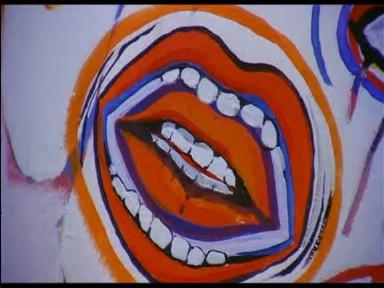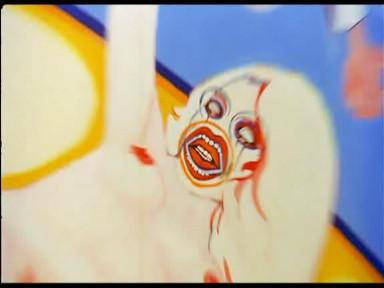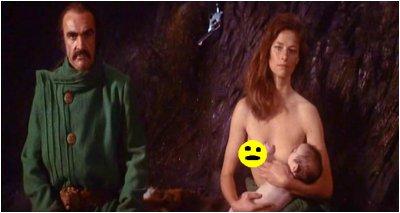In A Clockwork Orange, based upon the novel by Anthony Burgess, the Soviet Union has made, or will soon make, England its satellite. Youth slang is Russian, government is totalitarian, and crime is rampant. Gangs roam the streets, scoring drugs and ultraviolence. The story told is that of young gang member Alex DeLarge, a codpiece-sporting rapist and thug who, captured after the murder of a middle-aged woman, is subjected to Pavlovian reconditioning by the state’s moral police. The treatment makes him miserable and constantly nauseated – after a suicide attempt, he “recovers” and becomes his old self again.
I would like to focus for the time being not on the treatment, but on the murder that got young Alex arrested in the first place. The woman he kills lives alone in a massive apartment decorated garishly with painfully unsexy erotic art. She does yoga, is too thin, and wears too much makeup for a woman of her age. Alex kills her with the massive ceramic phallus that had adorned her living room. Several distinct tendencies can be inferred from this scene: 1) the equation of women with liberal sexuality 2) the equation of communism with liberalism and the Enlightenment generally 3) the equation of male violence with Nature and Authenticity.



The first point can be blamed broadly on the Seventies themselves, during which women were expected to radiate a kind of crass sexuality, supposedly liberatory, coextensive with male desires but for which women would be mocked, degraded and cheerfully exploited. A Clockwork Orange is full of old women dressing like sexpots; Alex’s mother also dresses like a Playboy teen, something evidently designed to disgust us. Women, according to Seventies ideology, are responsible for male fantasies, but must be put in their place when they fail sufficiently to arouse them. However, liberal sexuality in general, the falseness of women, is meant also to disgust us, almost to an equal degree. The cat lady is false, liberal sexuality, and the murder-rape is the authentic truth behind it.
The second point can be blamed on Burgess, although the Seventies marked the apogee of the old “capitalism and communism are equally bad” line, facilitating the translation of Burgess’s imbecility to the big screen. The Soviet Union, hypocritical moral guardian, has produced an England of false morality, in which its apparatchiks live the out-of-touch lives of hypertrophied liberal elites, curating their erotic art collections in isolation as they sneer at the situation of the proles. Burgess plays the part of a Burke, a Nabokov or a Vargas Llosa, a haut bourgeois smugly decrying bourgeois/e and bureaucrat alike for being soft and out of touch, unfamiliar with the Authenticity of love and violence, hiding behind decaying morality that they themselves no longer believe in, unaware that this critique is itself liberal as shit.
The third point has received nearly sufficient explanation already, but the codpieced gangsters of Clockwork Orange are, unsubtly, the heralds of the ubermensch, evangelizing an authentic violence beyond the false morality of the elite classes and the sniveling collectivity of the poor. The truth is rape, the wolf-pack against the sheep-herd, aestheticized atheism, and subversion of society. Society, of course, can’t take this inconvenient truth, and instills morality in Alex artificially, through technological and despicably modernist means. Again, modernism is conflated with hypocritical morality – and the solution, as always, is never more morality and less hypocrisy, but to throw the whole thing out the window and start again, a solution which is, likewise, modernist as shit, and not in a good way.
Zardoz presents us with a similar cautionary tale. The Exterminators, who like Alex’s droogs sport codpieces, roam the earth, repeating mantras affirming violence and condemning reproduction, vowing to rid the Earth of its plague of men, killing off the terrified peasant population in droves. Like the droogs, they rape, kill, beat. Our protagonist, an Exterminator, is by accident transported into the Vortex, a liberal-communist, New Age society ruled by psychic women in hippie getup. Unlike the peasants and Exterminators, the Immortals live well, spending their days in feasting and navel-gazing. They communicate through a ridiculous mass meditation ceremony that baffles Zed. In this decadent, immortal society, Zed is nearly executed, but ends up serving instead as an amusement and slave to the bored Immortals. He finds the citizens of the Vortex have a number of arcane, perverse moral rules; those who break them (generally men) are subjected to eternal aging by the matriarchy. A computer analysis of Zed reveals that he is the Chosen One sent to relieve mankind of its corrupt and stagnant existence. In the end, the Exterminators, heralding the return of nature and the end of perverse, liberal-communist morality, kill off the immortals.
So far, all three tendencies identified in Clockwork Orange can be identified in Zardoz. Liberalism, interchangeable with communism, is soft, womanly, hypocritically and arbitrarily moral, and begging, like the cat lady, for the violent release of death-by-codpieced-rapist. Against liberal-communist boredom, we release Nietzsche and the death-wish. Against women, the reproductive sex, we posit men, the killing sex. The endgame, in both cases, is the further postmodern breakdown of society.
But there’s a funny thing about Zardoz. It’s not that. It’s not quite that, anyway. There’s more to the story: Consuella, the de facto leader of the Immortals and initially the strongest voice in the campaign for Zed’s execution, survives the massacre, heading underground. Zed, meanwhile, doesn’t take much part in it. Instead, he absorbs all of the knowledge of the Immortals – including, significantly, the Quotations of Chairman Mao Zedong – and leaves the bloodbath to be with Consuella underground. They marry and have a child. As they die and the child leaves to seek a new life, the movie ends.
The Exterminators, at the start of Zardoz, repeat the mantra of their charlatan leader that death is better than reproduction, that reproduction is disgusting while violence is pure. The film’s final message is the precise opposite. While the Immortals didn’t reproduce out of liberal fear of the body, the Exterminators didn’t reproduce out of an irrational commitment to ideological violence and societal fragmentation. Where the message of A Clockwork Orange is that liberal solipsists deserve death at the hands of the noble, violent savage – or that the Enlightenment deserves death at the hands of the Rousseauvian or Nietzschean Counter-Enlightenment – Zardoz instead proposes the genuinely paleoconservative (against the weak Burke of Burgess), Catholic, and, yes, even communist message that each option is as solipsistic and sociopathic as the other. John Boorman, Zardoz’s director, picks out one woman of the Enlightenment and one man of the Counter-Enlightenment and makes them his Adam and Eve – though this aspect admittedly could be read as a concession to the literally revolutionary circular time of Nietzsche – and in the redemptive act of reproduction gives the human race a kind of hope that is totally distinct from any concept of the ubermensch. Zardoz, in other words, it is the anti-Clockwork Orange.

The argument could be made that Zed and Consuella’s child should be read as the ubermensch, the “overcoming” of both Enlightenment and Counter-Enlightenment, but I don’t think this holds up. The main difficulty is the clearly articulated fear of reproduction among both the Exterminators and the Immortals – the Exterminators are clearly Nietzsche and revolutionary time, far more than are the last men of the vortex, so their discrediting in Zed’s love for Consuella is much more important than the Immortals’ initial discrediting (which is rote Nietzsche). If Consuella’s last-man morality were really the ultimate target of derision, why should Zed love her? And if love is more important than the overcoming of soft, feminine liberalism, how can the movie be more Nietzschean than Catholic?
Couple last notes: yes, Alex gets married in the original ending of Clockwork Orange, but it’s a formality, and the message is still “heh, boys will be boys, and they’re still better than girls. Girls are dumb.” Also, yeah, Zardoz is The Time Machine, but that book sucks balls and is smug, moralistic pseudomarxism systematically stripped of hope.

Edited by blinkandwheeze ()
swampman posted:please stop posting
Kubrick turned the movie into something excessively sexual and shocking. At the same time, he omits the most disturbing elements of the book to avoid controversy. While sex is part of the book, it's not as omnipresent or tacky as it is in the movie. They don't wear codpieces. The giant phallus sculpture doesn't even exist in the book, nor anything like it; Alex kills the woman by hitting her with a bust of Beethoven.
AVE_MARIA_GRATIA_PLENA posted:Our protagonist, an Exterminator, is by accident transported into the Vortex, a liberal-communist, New Age society ruled by psychic women in hippie getup.
the vortex was a metropole sustained by exploiting the the brutals in the periphery. the zardoz head brought guns to the periphery for the exterminators to use to control the population and collect grain, and brought back grain to support the eternals in the vortex. zed didn't get back to the vortex by accident. arthur frayn who flew the zardoz head and who was in charge of managing the brutal periphery bred zed to overthrow the vortex. zed hid in the grain and killed arthur before arthur could explain his plot.
laputa was an allegory for the technologically enabled oppression of the periphery and the resultant inward cultural corruption of the metropole under the british empire. zardoz is the same, but adapted to the american empire and american culture of the 1970s.
solzhesnitchin posted:AVE_MARIA_GRATIA_PLENA posted:Our protagonist, an Exterminator, is by accident transported into the Vortex, a liberal-communist, New Age society ruled by psychic women in hippie getup.
the vortex was a metropole sustained by exploiting the the brutals in the periphery. the zardoz head brought guns to the periphery for the exterminators to use to control the population and collect grain, and brought back grain to support the eternals in the vortex. zed didn't get back to the vortex by accident. arthur frayn who flew the zardoz head and who was in charge of managing the brutal periphery bred zed to overthrow the vortex. zed hid in the grain and killed arthur before arthur could explain his plot.
laputa was an allegory for the technologically enabled oppression of the periphery and the resultant inward cultural corruption of the metropole under the british empire. zardoz is the same, but adapted to the american empire and american culture of the 1970s.
thats all accurate (and it makes the Vortex more like an ancient city-state, ironically, than anything) but i do think there at least appears to be the same weird conflation of liberalism and communism as in clockwork orange and the same weird nietzschean "liberalism is bad because it makes people soft" replacing "liberalism is bad because it relies on hyperexploitation to continue existing" -- but then it turns into a version of the 2002 remake of the Time MAchine where the Morlocks explicitly win, so, i mean, yes, a straight marxist reading would also work, but i think the way it refuses to go through with the nietzsche stuff entirely is also interesting
swampman posted:the only socially valuable form of art is the parade
as long as you're including processions this is t.r.u.
Lessons posted:horseshit you came up with whilst smoking meth.
don't methshame
KilledInADuel posted:the best parody of the new left is sleeper by woody allen.
i like Love in the Ruins, which also turned out to be right
A (Trans)substantial Analysis of Anti-Soviocatholicism in Azumanga Diaoh: Volume I

Azumanga Daioh is one of the most widely-read, critically-acclaimed and financially successful Japanese mangas ever produced. Later adapted into a television anime by J.C. Staff, it remains one of the most influential and enduring works of popular culture both within Japan's national borders and in its cultural relation to the world at large, and is widely cited as a critical impetus in the move towards "slice-of-life" and "moe" anime in contrast to the action and kids features most popular before. While arguably its direct style has waned, (Nichijou, in many ways a successor visually and thematically to Azumanga, was a financial debacle for its financiers at Kyoto Animation and was cancelled after a mere two seasons), it can be seen as the prefiguring some of the most popular contemporary anime series including Lucky Star, The Melancholy of Haruhi Suzumiya, K-On! and K-On!!.
To those who are not familiar, Azumanga focuses on the daily and school life of five highschool girls, Sakaki, Yomi, Tomo, Osaka and Chiyo. At first glance, one might interpret this as a truly feminine space: all of the main student characters, as well as their most prominent teachers, are women. But the engima, the central contradiction at the heart of Azumanga is Kimura-sensei, the only major and reoccurring male character within the feminine literary existence of the otherwise all-woman ensemble. Moreover, this intrusion is not a simple matter of gender, but more sinister: Kimura-sensei is implied, unexplicitly but no less candidly or infrequently, to be essentially a pedophile. He admits openly to teach at a girl's school so that he can observe young girls, sometimes going so far as to observe their swimming and track practice so to ogle the cast in revealing uniforms. In this, the trope of the Catholic pedophile priest is evoked.

Figure I: Hmm, are they brothers?
However, the allegorical anti-Catholic aspect of the character is by no means limited to aping traditional Western stereotypes, but conforms to the peculiarity of Japanese history and culture. While the Japanese perception of the Catholic is similar to that in the West proper - predatory, foreign, disloyal, in a word, Other - there is a unique historical aspect that here comes into play. Where the Anglo-American traditional is fearful of Catholics as an aberration, a distortion of original Protestant truth, for the Japanese the Catholic is always the invader. Let us not forget that the blood of so many Catholic martyrs, missionary and convert, were shed in the consolidation of the the Japanese feudal order under the Tokugawa clan, and the efforts of the same to eradicate Catholic influence on account of its subversive and liberatory potential. In this we find the answer to contradiction of Kimura-sensei's male intrusion to the feminine literary event-space that unfolds in the pages of Azumanga: it is not, in the final analysis, a male intrusion at all, but a Catholic one. Where the girls and female teachers represent the pure, innocent and playful Japanese Buddhists and Shinto, Kimura-sensei is the perverted, corrupting influence of Rome and its Legions. His menacing intrusion is not strictly speaking a function of his masculinity, but in his role as Catholic and foreign.
Yet, lest we miss the forest for the trees, Kimura-sensei embodies another aspect largely absent in the main and supporting characters: that of the stolid, rigid and insipid. While his menace clearly seeps through and defines his character, Kimura-sensei's external presentation is one of complete banality: his interminable slack jaw, his vacant eyes, his empty monotone. Where, dear reader, can we discover the ideological roots of this formulation? There is only one answer.

Figure II: The resemblance is uncanny
While Europe no doubt feared the influence of Soviet power, Japan inhabits a unique constellation of geopolitical situationality compared to Germany. While both struggled with internal radical communist dissent, (the Red Army Faction in the FRG, and the Japanese Red Army in Japan), and the threat of Soviet invasion, (half-completed in Germany, forestalled entirely by American conventional, diplomatic and atomic power in Japan), Japan was hemmed in on two fronts: the Soviets to the North and the Chinese under Mao to the East. This created a terrible anxiety in the souls of the Japanese bourgeoisie, and one that persists in its particular form to this day. While mitigated by the fall of the Soviet Union and the detente achieved between China and NATO, it continues to creep in and expose itself through the hysteria over North Korea, the conflict with China and Korea over the possession of various islands in the East China Sea, and works of culture like Azumanga.
Where Kimura-sensei pederastic menace springs from his nature as Catholic and foreign, his monotone banality is birth from his depiction as Soviet and communist. He is a pure expression of the terror the bourgeoisie feels in the face of collectivist "bureaucracy", he is the "tyrannical" "totalitarian" headmaster that they hold up to the working masses as the only alternative to the rule of capital.
Finally, culminating in one of the most brilliant moves of propagandistic cinema since Riefensthal's Der Triumph des Willens, these two threads of anti-Catholic and anti-Soviet anxiety are woven together in a magnificent tapestry:
The shock and comedy here is accomplished through a double-movement. To the Anti-Soviocatholic, the priest-figure of Kimura-sensei becomes not only a menace, but a hypocrite, and his vow of celibacy is nothing but a veneer, but this is by no means the end of the story. In his role as Soviet bureaucrat, Kimura-sensei is de-sexualized, de-personalized, even de-humanized, thus excluding the possibility of him as a family man. To quote Sting, "Do the Russians love their children too?" Through the ironic subversion the negative, Catholic and Soviet qualities of Kimura-sensei are all the more reinforced, bolted together and synthesized, irrevocably and devastatingly. Domo arigato, mister Roboto, and good night.
jools posted:lol at maggotmaster turning up to upvote that epic burn 'gainst prop-d
he likes anime a lot.
daddyholes posted:. o O (Better get the "feel" of the room here before I admit discussing movies with friends...........)
I agree with your basic point of your post but i would hardly call any of these people friends. Enemies maybe, friends no. Anyone who attempts to discuss a movie with me, is my enemy. QED